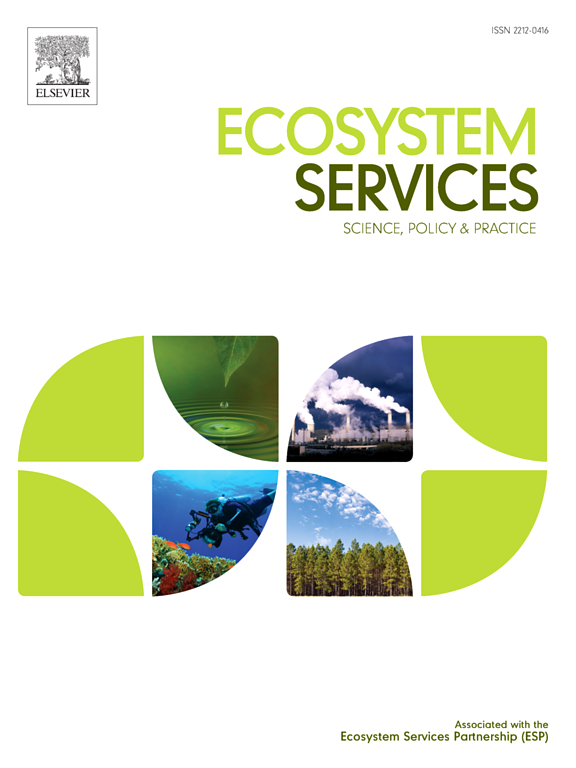Effects of invasive species on the ecosystem services of a tropical insular protected area in Brazil
IF 6.6
2区 环境科学与生态学
Q1 ECOLOGY
引用次数: 0
Abstract
Invasive alien species (IAS) represent a global problem for biodiversity conservation, and a growing concern involving IAS is related to their impacts on ecosystem services. However, their effects on ecosystem services in insular ecosystems are poorly known, which are particularly relevant and concerning due to the fragility and limited resources in these areas for several organisms, including humans. Therefore, the present study aimed to inventory ecosystem services and assess the impact of IAS on these services and the terrestrial ecosystems of the Fernando de Noronha Archipelago, Brazil, which is a tropical protected area. The approach was applied to four IAS: black rat (Rattus rattus), domestic cat (Felis catus), tegu lizard (Salvator merianae), and lead tree (Leucaena leucocephala). A worksheet for ecosystem services was created, using the subdivisions defined in the zoning of the protected areas of Fernando de Noronha as management units, namely Urban Area, Beach Area, Green Area, Primitive Area, and Secondary Island. Additionally, two quantitative approaches were combined: the INvasive Species Effects Assessment Tool (INSEAT) to assess the positive and negative effects of IAS on ecosystem services, based on a questionnaire applied to experts; and the Integrated Valuation of Ecosystem Services and Tradeoffs (InVEST) software to estimate the risk of impacts from IAS. In total, 21 ecosystem services, 41 benefits, and 10 groups of benefitting social actors were identified in Fernando de Noronha. In general, all IAS presented risks to the ecosystem services of Fernando de Noronha, especially F. catus and R. rattus. According to the impact index, the IAS caused negative effects to most ecosystem services considered, but the effects were more pronounced on the provisioning and cultural ecosystem service groups. On the other hand, a positive effect was found for L. leucocephala on regulating and maintenance services, although with a low impact index. With the exception of the Urban Area, all management units showed a high risk of being impacted by IAS, especially the Primitive Area. The main social actors impacted by the IAS were the local community, the floating population, and the Administration. The present study is the first to combine these quantitative techniques (INSEAT and InVEST) and represents a set of guidelines for ecosystem-based management to mitigate the impact of IAS, aiming at the maintenance and improvement of ecosystem services within protected areas in insular environments.
入侵物种对巴西热带岛屿保护区生态系统服务的影响
外来入侵物种是生物多样性保护的一个全球性问题,其对生态系统服务的影响日益引起人们的关注。然而,它们对岛屿生态系统中生态系统服务的影响所知甚少,由于这些地区的脆弱性和资源有限,对包括人类在内的几种生物来说,这些影响尤其相关和令人担忧。因此,本研究旨在对热带保护区巴西费尔南多迪诺罗尼亚群岛的生态系统服务进行盘点,并评估IAS对这些服务和陆地生态系统的影响。该方法应用于黑鼠(Rattus Rattus)、家猫(Felis catus)、沙蜥(Salvator merianae)和铅树(Leucaena leucocephala) 4种IAS。创建了生态系统服务工作表,使用Fernando de Noronha保护区分区中定义的细分作为管理单元,即城区,海滩区,绿地区,原始区和次级岛。此外,还结合了两种定量方法:入侵物种影响评估工具(INSEAT),基于对专家的问卷调查,评估外来入侵物种对生态系统服务的积极和消极影响;以及生态系统服务与权衡综合评估(InVEST)软件,用于估计国际会计准则影响的风险。Fernando de Noronha总共确定了21种生态系统服务、41种效益和10个受益社会行为者群体。总体而言,所有外来入侵物种都对费尔南多-迪诺诺哈的生态系统服务功能构成威胁,尤其是褐家鼠和褐家鼠。从影响指数来看,IAS对大多数生态系统服务都产生了负面影响,但对供应和文化生态系统服务类的影响更为明显。另一方面,白头草对植物的调节和维持功能有积极作用,但影响指数较低。除市区外,所有管理单位均显示受IAS影响的风险较高,尤其是原始区。受IAS影响的主要社会行为者是当地社区、流动人口和行政当局。本研究首次结合了这些定量技术(INSEAT和InVEST),并为基于生态系统的管理提供了一套准则,以减轻IAS的影响,旨在维持和改善岛屿环境保护区内的生态系统服务。
本文章由计算机程序翻译,如有差异,请以英文原文为准。
求助全文
约1分钟内获得全文
求助全文
来源期刊

Ecosystem Services
ECOLOGYENVIRONMENTAL SCIENCES&-ENVIRONMENTAL SCIENCES
CiteScore
14.90
自引率
7.90%
发文量
109
期刊介绍:
Ecosystem Services is an international, interdisciplinary journal that is associated with the Ecosystem Services Partnership (ESP). The journal is dedicated to exploring the science, policy, and practice related to ecosystem services, which are the various ways in which ecosystems contribute to human well-being, both directly and indirectly.
Ecosystem Services contributes to the broader goal of ensuring that the benefits of ecosystems are recognized, valued, and sustainably managed for the well-being of current and future generations. The journal serves as a platform for scholars, practitioners, policymakers, and other stakeholders to share their findings and insights, fostering collaboration and innovation in the field of ecosystem services.
 求助内容:
求助内容: 应助结果提醒方式:
应助结果提醒方式:


